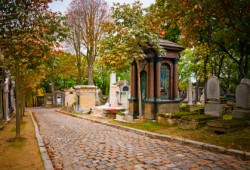Grief Tourism
 Most of us are already aware of the appeal of walking through an old cemetery. Rich with history and age, beautiful in terms of scenery, and filled with a sense of serenity that’s hard to capture in our modern world, older cemeteries have a park-like atmosphere that appeals to many different types of people.
Most of us are already aware of the appeal of walking through an old cemetery. Rich with history and age, beautiful in terms of scenery, and filled with a sense of serenity that’s hard to capture in our modern world, older cemeteries have a park-like atmosphere that appeals to many different types of people.
This recent resurgence of interest in visiting cemeteries has led to a phenomenon known as grief tourism. Much less depressing than it actually sounds, grief tourism (also known as dark tourism) is considered any vacation or trip in which visiting cemeteries is the primary objective.
Where Grief Tourism Takes Place
The Pere-Lachaise Cemetery in Paris, which first opened in 1804, receives more than a million and a half visitors a year. (Many of them come to see the grave of Jim Morrison, although there are plenty other celebrities here to catch the eye.) Other popular Paris destinations include Montparnasse Cemetery and Saint-Denis, where many of France’s monarchs have been laid to rest.
Westminster Abbey in London has a number of famous graves on site, and popular cemeteries in the United States can be found in many different locations, including Louisiana, Washington DC, and most major cities. Military cemeteries are especially popular in grief tourism, as they are almost always found in areas where traditional tourism is also quite high.
People also go beyond burial grounds when they’re on a grief tour to anywhere history and death combine. You can visit sites of historic battles, ancient castles, or even concentration camps. More recent man-made disasters like those that occurred in Chernobyl or Ground Zero in New York also draw crowds.
What is Dark/Grief Tourism?
Grief tourism is defined as any type of travel to sites where death and tragedy have occurred. Some people come to learn the history, while others want to pay their respects or visit a memorial. Still others might have a personal connection to the destination, whether through a relative or a distant ancestor. Less popular but still common are those who intend to hunt for paranormal activity or otherwise make a sport out of the spectacle of grief.
Thanks in large part to this latter group, grief tourism has been at the center of some controversy in recent years. Because some of these locations charge money for entry (and because the sales of souvenirs may not be sanctioned by the affiliated historical societies), exploitation can and does occur. That is why most organizations recommend you always act with respect for the deceased and refrain from making a game out of other people’s grief when you visit one of these sites.



